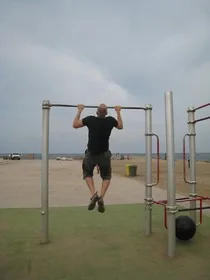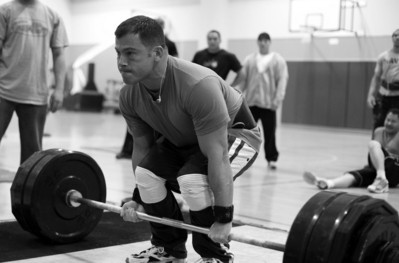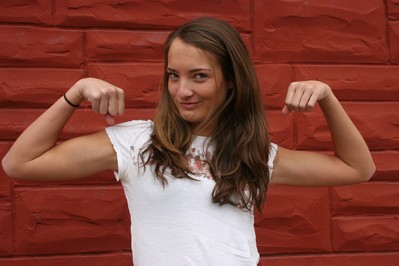
A while back at the gym I was doing bench press. For my body weight, I was benching a significant amount. Out of the corner of my eye, I noticed a guy across the way doing wide-grip pull-ups.
When I finished bench press, I moseyed over to the pull-up bar to give it a shot. How embarrassing! I used every ounce of energy I had to do 2… okay, one and a half.
The following week, I saw the same guy in the gym doing handstand push-ups. I decided to start doing pull-ups regularly, and now I’m up to in 10 for consecutive wide-grip pull-ups.
I’m sure you’ve heard the phrase about being “Army Strong.” I got to wondering about the difference between being weight-lifting strong and being bodyweight strong and if the difference could mean something significant for the triathlete.
What kind of strength does one need as a triathlete?
The next couple posts are going to cover some of what I learned as I explored this question.
In general, when it comes to strength training, the trend these days in the typical gym is people doing “cosmetic workouts.”
In other words, they are going for the looks.
I hesitate to call it “bodybuilding” because true bodybuilding involves much more than what the average person thinks.
In most gyms, men mainly want the large chest and big biceps, and often ignore other muscle groups like legs and back. We’ve all seen guys with huge arms and puny legs. Women are often after the slender body with shapely glutes.
Functional Strength Training
In cosmetic workouts, there is very little consideration for the functionality of the body.
What I mean by functionality, is the use of the body for purposes other than the exercises by which it acquired the strength or appearance.
The idea behind functional strength training is that the body is integrated, with hundreds of muscles working together to perform a variety of functions. Functional strength programs are designed to mimic everyday activities. These activities range from moving furniture to swinging a golf club.
A functional exercise will utilize reflex responses to keep balance, force the body to maintain a center of gravity and/or have a high carryover into work or sport. These movements have been shown to improve:
- strength
- power
- endurance
- flexibility
- coordination
- balance
- agility
- speed
So for example, the guy who spends a year adding inches to his bicep using a curl machine cannot do much more with his body at year’s end then when he started, other than curl more weight on that machine. Thus, his workouts are not “functional.”
On the other hand, a person who lifts and carries heavy sandbags has functional strength, which he or she can use when lifting, carrying, or moving other heavy things such as furniture, heavy luggage, boxes, etc.
For the sport of triathlon, “functional strength” relates to the specific movements associated with swimming, biking and running. Functional strength training is important for a triathlete. It promotes better muscular balance and joint stability, which will lead to fewer injuries and increased performance as a triathlete.
Here is a functional strength training routine for swimming using tension bands and an ergometer.
Pros & Cons of Weight Machines For Triathletes
Weight machines are popular in the typical gym, but they have very little crossover benefit to building functional strength for a triathlete. Machines tend to isolate muscle groups.
A gym will typically have a circuit of machines set up where one works the chest, one the quadriceps, one the shoulders, one the triceps, and so on and so forth. There is no scenario related to the sport of triathlon where muscles work in isolation. No muscular balance or coordination is required when pushing a handle on a machine, and so all of the accessory muscles, tendons, and ligaments that come into play while swimming, biking, and running are not being worked.
That’s not to say there are no benefits to using machines. For example, when rehabilitating an injury where you cannot support a barbell, dumbbells, or your own body weight, a machine can be helpful. Similarly, an injured leg might be rehabilitated on a spin bike.
A non-injury related reason for using machines would be the need for an indoor cardio machine such as a treadmill or spin bike. One might choose to use these as an option during bad weather, or for focused interval training.
Also to be fair with respect to weight machines, they can be helpful in increasing strength in specific muscle groups, which presumably is advantageous to any athlete. Newer cable machines have been designed with functional strength training in mind.
Here’s an example of a functional strength training routine using a cable machine:
When it comes to machines, it appears that the cable machines are most likely to promote functional strength for triathletes, while the typical gym machine will offer very little value for functional strength.
Here are several cable machine strength training exercises.
When it comes to the strength issue of a triathlete, there is also the question of bodyweight exercises verses free-weight exercises, which is the subject of the next post.
I’m over 40 years old, but I don’t give up easily. It wasn’t too long ago that I was exploring the idea of doing my first triathlon. If I can do it, you can too! I'm proof that with a little determination and training, you can get a great deal of fulfillment participating in marathons, triathlons… even ultramarathons.






